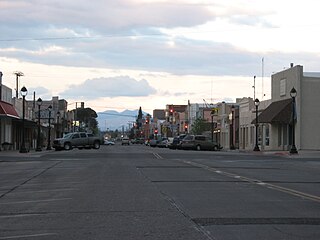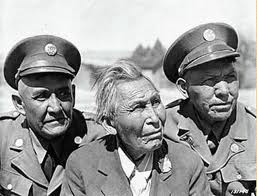
Chiricahua is a band of Apache Native Americans.

Globe is a city in Gila County, Arizona, United States. As of the 2020 census, the population of the city was 7,249. The city is the county seat of Gila County. Globe was founded c. 1875 as a mining camp. Mining, tourism, government and retirees are most important in the present-day Globe economy.

Peridot is an unincorporated community and census-designated place (CDP) in Gila and Graham counties in the U.S. state of Arizona. The population was 1,350 at the 2010 census.

San Carlos is a census-designated place (CDP) in Gila County, Arizona, United States. The population was 4,038 at the 2010 census, up from 3,716 in 2000.

Safford is a city in Graham County, Arizona, United States. According to the 2020 Census, the population of the city is 10,129. The city is the county seat of Graham County.

Cibecue is a census-designated place (CDP) in Navajo County, Arizona, United States, on the Fort Apache Indian Reservation. The population was 1,713 in the 2010 United States Census.

Athabaskan is a large family of Indigenous languages of North America, located in western North America in three areal language groups: Northern, Pacific Coast and Southern. Kari and Potter (2010:10) place the total territory of the 53 Athabaskan languages at 4,022,000 square kilometres (1,553,000 sq mi).
The Apache are several Southern Athabaskan language–speaking peoples of the Southwest, the Southern Plains and Northern Mexico. They are linguistically related to the Navajo. They migrated from the Athabascan homelands in the north into the Southwest between 1000 and 1500 CE.

The Western Apache live primarily in east central Arizona, in the United States and north of Mexico in the states of Sonora and Chihuahua. Most live within reservations. The Fort Apache Indian Reservation, San Carlos Apache Indian Reservation, Yavapai-Apache Nation, Tonto Apache, and the Fort McDowell Yavapai Nation are home to the majority of Western Apache and are the bases of their federally recognized tribes. In addition, there are numerous bands. The Western Apache bands call themselves Ndee (Indé). Because of dialectical differences, the Pinaleño/Pinal and Arivaipa/Aravaipa bands of the San Carlos Apache pronounce the word as Innee or Nnēē:.

The Yavapai–Apache Nation is a federally recognized Native American tribe in the Verde Valley of Arizona. Tribal members share two culturally distinct backgrounds and speak two indigenous languages, the Yavapai language and the Western Apache language. The Yavapai–Apache Nation Indian Reservation, at 34°37′10″N111°53′46″W, consists of five non-contiguous parcels of land located in three separate communities in eastern Yavapai County. The two largest sections, 576 acres (233 ha) together – almost 90 percent of the reservation's territory, are in the town of Camp Verde. Smaller sections are located in the town of Clarkdale 60.17 acres (24.35 ha), and the unincorporated community of Lake Montezuma. The reservation's total land area is 642 acres (260 ha). The total resident population of the reservation was 743 persons as of the 2000 census. The 2010 Census reported 1,615 people on the reservation. Of these, 512 lived in Camp Verde, 218 in Clarkdale, and only 13 in Lake Montezuma.

The Tonto Apache is one of the groups of Western Apache people and a federally recognized tribe, the Tonto Apache Tribe of Arizona. The term is also used for their dialect, one of the three dialects of the Western Apache language.

Keith Hamilton Basso was a cultural and linguistic anthropologist noted for his study of the Western Apaches, specifically those from the community of Cibecue, Arizona. Basso was professor emeritus of anthropology at the University of New Mexico and earlier taught at the University of Arizona and Yale University.

The San Carlos Apache Indian Reservation, in southeastern Arizona, United States, was established in 1872 as a reservation for the Chiricahua Apache tribe as well as surrounding Yavapai and Apache bands removed from their original homelands under a strategy devised by General George Crook of setting the various Apache tribes against one another. Once nicknamed "Hell's Forty Acres" during the late 19th century due to poor health and environmental conditions, today's San Carlos Apaches successfully operate a Chamber of Commerce, the Apache Gold and Apache Sky Casinos, a Language Preservation program, a Culture Center, and a Tribal College.

The Fort Apache Indian Reservation is an Indian reservation in Arizona, United States, encompassing parts of Navajo, Gila, and Apache counties. It is home to the federally recognized White Mountain Apache Tribe of the Fort Apache Reservation, a Western Apache tribe. It has a land area of 1.6 million acres and a population of 12,429 people as of the 2000 census. The largest community is in Whiteriver.
Grenville Goodwin, born Greenville Goodwin (1907–1940), is best known for his participant-observer ethnology work among the Western Apache in the 1930s in the American Southwest. Largely self-taught as an anthropologist, he lived among the Apache for nearly a decade, and learned their stories and rituals. His monograph The Social Organization of the Western Apache was considered a major contribution to American ethnology. It was published in 1941 after his death at age 32, when his promising career was cut short.

The Yavapai are a Native American tribe in Arizona. Historically, the Yavapai – literally “people of the sun” – were divided into four geographical bands who identified as separate, independent peoples: the Ɖulv G’paaya, or Western Yavapai; the Yaavpe', or Northwestern Yavapai; the Gwev G’paaya, or Southeastern Yavapai; and the Wiipukpaa, or Northeastern Yavapai – Verde Valley Yavapai.
Pliny Earle Goddard was an American linguist and ethnologist noted for his extensive documentation of the languages and cultures of the Athabaskan peoples of western North America. His early research, carried out under the auspices of the University of California, Berkeley, focused on the Hupa and adjacent Athabaskan groups in northwestern California. After moving to New York in 1909 at the invitation of Franz Boas his scope expanded to include the Athabaskans of the Southwest, Canada, and Alaska. During the 1910s and 1920s. as Boas's junior colleague at the American Museum of Natural History and Columbia University, Goddard played a major role in creating the academic infrastructure for American Indian linguistics and anthropology in North America.

Bylas is an unincorporated community and census-designated place in Graham County, Arizona, United States, located within the San Carlos Apache Indian Reservation. As of the 2010 census, its population was 1,962. The community has a medical clinic, a police substation, and a market. Bylas is an Apache settlement divided into two communities, one of the White Mountain Apache, the other of San Carlos and Southern Tonto Apache. It is named for Bylas a chief of the Eastern White Mountain Apache band.

Southern Athabaskan is a subfamily of Athabaskan languages spoken primarily in the Southwestern United States with two outliers in Oklahoma and Texas. The languages are spoken in the northern Mexican states of Sonora, Chihuahua, Coahuila and to a much lesser degree in Durango and Nuevo León. Those languages are spoken by various groups of Apache and Navajo peoples. Elsewhere, Athabaskan is spoken by many indigenous groups of peoples in Alaska, Canada, Oregon and northern California.

John Rope (circa 1855/1863 – 8 August 1944, born Tlodilhil was a White Mountain Apache clan leader and Apache scout who received a medal of honor. Rope was born somewhere between Old Summit and Black River, Arizona, but says his earliest memories are from his time near Cedar Creek, which is just west of Fort Apache. Rope's father was Nayundiie, a White Mountain Apache clan leader. He was foster brother to Mickey Free.

















